Study of a New Novel HVOAF Coating Based on a New Multicomponent Al80Mg10Si5Cu5 Alloy
This technical summary is based on the academic paper "Study of a New Novel HVOAF Coating Based on a New Multicomponent Al80Mg10Si5Cu5 Alloy" by Ester Villanueva, Iban Vicario, Carlos Vaquero, Joseba Albizuri, Maria Teresa Guraya, Nerea Burgos, and Iñaki Hurtado, published in Coatings (2024).
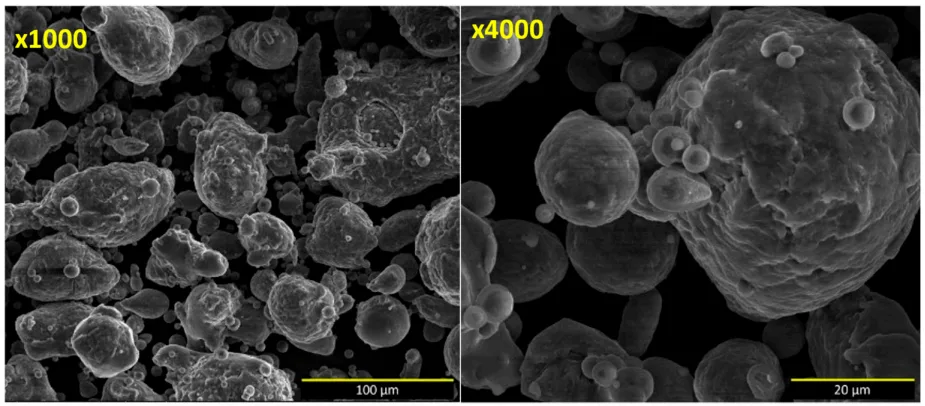
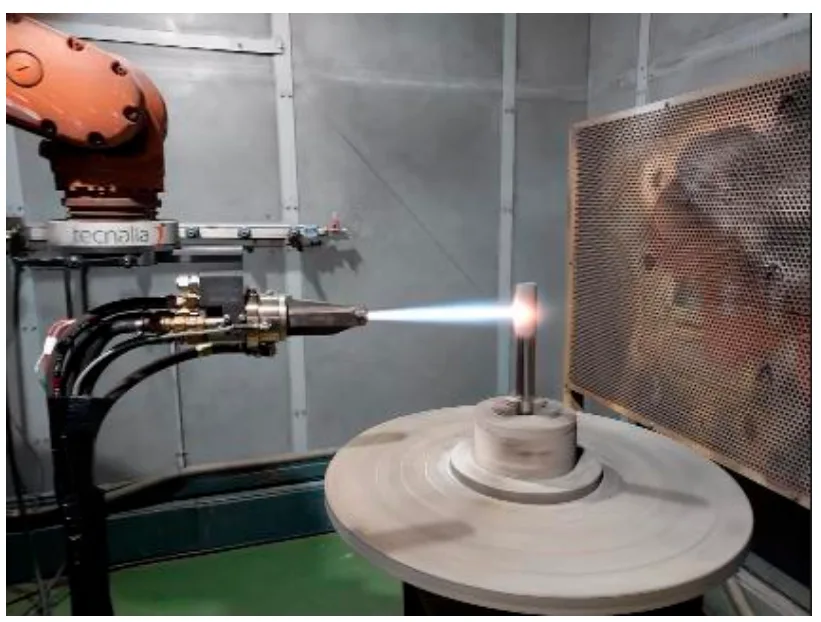
Keywords
- Primary Keyword: HVOAF Coating
- Secondary Keywords: multicomponent aluminum alloy, thermal spray coating, Al80Mg10Si5Cu5 alloy, wear resistance, electrical conductivity, corrosion resistance
Executive Summary
- The Challenge: To overcome the inherent limitations of lightweight aluminum alloys in wear resistance, hardness, and electrical conductivity for demanding automotive and hydrogen-related applications.
- The Method: A novel multicomponent Al80Mg10Si5Cu5 alloy was applied onto a standard A6061 aluminum substrate using a newly designed hybrid High Velocity Oxy-Fuel and Plasma (HVOAF) spraying process.
- The Key Breakthrough: The new HVOAF coating improved hardness by 50%, increased electrical conductivity by 3.3 times, reduced friction by over 20%, and cut the wear rate by over 50% compared to the uncoated substrate.
- The Bottom Line: This hybrid HVOAF coating technology provides a commercially viable method to significantly enhance the performance of aluminum components, making them suitable for high-wear and electrically sensitive applications previously dominated by heavier materials.
The Challenge: Why This Research Matters for HPDC Professionals
In the push for lightweighting and fuel economy, particularly in the automotive sector, aluminum has become a critical alternative to steel. However, standard aluminum alloys often fall short in demanding applications requiring high wear resistance, hardness, and electrical conductivity. Traditional protective coatings exist, but applying them effectively to aluminum substrates without degrading the material or creating adhesion issues is a persistent challenge. Furthermore, the development of advanced materials like multicomponent alloys (or High Entropy Alloys) has been promising in labs but limited by complex and costly manufacturing processes, making large-scale industrial application difficult. This research addresses the critical need for a robust, scalable process to apply a high-performance, lightweight coating that elevates the properties of common aluminum alloys to meet next-generation industrial demands.
The Approach: Unpacking the Methodology
The study's success hinges on a novel combination of material and process. The researchers developed a new coating that fundamentally upgrades the performance of a standard aluminum substrate.
Method 1: Advanced Material Formulation & Preparation
- Coating Material: A new multicomponent alloy with the composition Al80Mg10Si5Cu5 was developed. This alloy was produced using a High-Pressure Die-Casting (HPDC) process to ensure a fine microstructure, then converted into a powder via gas atomization, with a final particle size between 63 and 250 µm.
- Substrate Material: Commercially extruded A6061 aluminum alloy plates, a common material in the automotive industry, were used as the base. The plates were ground, cleaned with propanol, and dried before coating.
Method 2: Hybrid HVOAF Thermal Spray Process
- Equipment: A custom-designed HVOAF system (Kombus+) was used, which combines High Velocity Oxy-Fuel (HVOF) combustion with a thermal plasma and an auxiliary cold gas. This hybrid approach offers greater control over process temperature and material deposition.
- Key Process Parameters: Methane was used as the fuel gas at 380 L/min. The oxygen flow rate was 300 L/min, with an airflow of 1500 L/min at 14 bar. The spray gun was positioned 300 mm from the substrate and moved at 0.9 m/s, creating a coating thickness of 50 to 130 µm. The substrate temperature was maintained at 200 °C during the process.
Method 3: Comprehensive Performance Characterization
- Analysis Techniques: The resulting coating was rigorously tested using Optical Microscopy (OM), Scanning Electron Microscopy (SEM), Energy Dispersive X-ray Spectroscopy (EDS), and X-ray Diffraction (XRD) to analyze its microstructure and chemical composition.
- Mechanical & Electrical Testing: Vickers hardness tests, dry sliding wear tests (ball-on-disk method following ASTM G99-05), and electrical conductivity measurements (%IACS) were performed to quantify the performance improvements.
The Breakthrough: Key Findings & Data
The hybrid HVOAF process produced a dense, strongly adhered coating that dramatically improved the substrate's key properties.
Finding 1: Superior Hardness and Microstructure Adhesion
The new coating delivered a significant boost in hardness. The interface between the coating and the A6061 substrate showed the highest hardness values, corroborating the microstructural analysis. As shown in the hardness graph derived from Figure 7, the A6061 base material measured approximately 75 HV10. The coating itself achieved a hardness of 133 HV10 ± 4.5, nearly double that of the substrate. Most impressively, the interface area, enriched with a hard Al2CuMg phase, reached a hardness of around 200 HV10. This hard intermediate layer contributes to the coating's excellent adhesion, and crucially, no cracks were observed after indentation, indicating it is not a fragile phase.
Finding 2: Drastic Reduction in Friction and Wear
The tribological tests revealed a remarkable improvement in wear resistance. The uncoated A6061 substrate exhibited a high coefficient of friction (COF) of 0.52 and a high wear rate. In contrast, the Al80Mg10Si5Cu5 HVOAF coating reduced the steady-state COF by 23% to 0.40. More significantly, the wear rate coefficient (K) was slashed by 55.83%. As detailed in Table 5, the wear rate for the uncoated substrate was 1.2 x 10⁻³ mm³/N·m, while the coated sample's wear rate was only 5.3 x 10⁻⁴ mm³/N·m. Analysis of the wear tracks (Figure 10) showed the uncoated sample suffered from severe delamination and cracks, whereas the coated sample exhibited only mild abrasion (ploughing), confirming a shift to a much less destructive wear mechanism.
Practical Implications for R&D and Operations
- For Process Engineers: This study suggests that the HVOAF process parameters (fuel/oxygen flow, spray distance, powder feed rate) are critical for controlling coating porosity and thickness. Optimizing these variables can further enhance performance, particularly corrosion resistance, by adjusting preheating and the angle of incidence.
- For Quality Control Teams: The data in Figure 7 of the paper illustrates that the hardness at the coating-substrate interface is a key indicator of successful adhesion and performance. This could inform new quality inspection criteria focused on interfacial integrity rather than just surface hardness.
- For Design Engineers: The findings indicate that this HVOAF coating can enable the use of lightweight A6061 aluminum in applications previously requiring heavier or more expensive materials. The combination of high wear resistance, improved hardness, and high electrical conductivity makes it a candidate for automotive components like engine parts, battery components, and parts in contact with hydrogen.
Paper Details
Study of a New Novel HVOAF Coating Based on a New Multicomponent Al80Mg10Si5Cu5 Alloy
1. Overview:
- Title: Study of a New Novel HVOAF Coating Based on a New Multicomponent Al80Mg10Si5Cu5 Alloy
- Author: Ester Villanueva, Iban Vicario, Carlos Vaquero, Joseba Albizuri, Maria Teresa Guraya, Nerea Burgos, and Iñaki Hurtado
- Year of publication: 2024
- Journal/academic society of publication: Coatings
- Keywords: coating; plasma; HVOF; multicomponent aluminum alloy; wear; electrical conductivity; hardness; microstructure
2. Abstract:
This paper presents and demonstrates the development of a new lightweight coating for aluminum alloy from a novel multicomponent alloy based on the AlSiMgCu system. The coating was applied using a newly designed approach that combined high velocity oxy-fuel (HVOF) and plasma spraying processes. This hybrid technique enables the deposition of coatings with enhanced performance characteristics. The optical microscopy (OM) and scanning electron microscopy with energy dispersive X-ray spectroscopy (SEM + EDS) revealed a strong adhesion and compaction between the multicomponent coating and the A6061 substrate. The new coating improved hardness by 50% and increased electrical conductivity by approximately 3.3 times compared to the as-cast alloy. Corrosion tests showed a lower corrosion rate, comparable to thermally treated A6061 alloy. Tribological tests indicated over 20% reduction in friction and over 50% reduction in wear rate. This suggests that multicomponent aluminum coatings could improve automotive and parts in contact with hydrogen by enhancing hydrogen fragilization resistance, corrosion resistance, electrical conductivity, and wear properties, with further optimization of thermal spraying potentially boosting performance even further.
3. Introduction:
Protective coatings are highly effective in extending the lifespan of metallic structures across various sectors, including automotive parts where aluminum is increasingly used over steel for fuel economy benefits. Thermal spray is a versatile technology for applying metallic and ceramic coatings to combat wear, corrosion, and high-temperature environments. Among advanced thermal spray techniques, High Velocity Oxy-Fuel (HVOF) is notable for producing compact coatings with excellent resistance. This research explores the use of a novel multicomponent alloy, also known as a High Entropy Alloy (HEA), as a coating material. These alloys offer substantial improvements in mechanical properties. The study utilizes a new hybrid thermal spray process that combines HVOF and plasma technologies to deposit a coating of a new Al80Mg10Si5Cu5 alloy onto an A6061 aluminum substrate, aiming to create a high-performance, lightweight coated material suitable for advanced applications.
4. Summary of the study:
Background of the research topic:
The study is situated within the field of materials science and surface engineering, specifically focusing on protective coatings for lightweight aluminum alloys. The increasing use of aluminum in industries like automotive necessitates enhancements in its surface properties, such as wear resistance, corrosion resistance, and hardness, which are often inferior to those of steel.
Status of previous research:
Previous research has explored various thermal spray techniques, including HVOF, to deposit ceramic (e.g., carbides, oxides) and metallic coatings on aluminum substrates. While effective in increasing hardness, these often have drawbacks related to mechanical properties or adhesion. Some studies have investigated aluminum-based coatings, but limited information exists on their wear characteristics in automotive applications. Concurrently, research into multicomponent alloys/HEAs has shown their potential for superior mechanical properties, but large-scale production remains a challenge.
Purpose of the study:
The primary purpose was to develop and characterize a new lightweight coating for aluminum alloys. This involved using a novel multicomponent Al80Mg10Si5Cu5 alloy and applying it with a newly designed hybrid HVOAF (HVOF + plasma) thermal spray system. The objective was to evaluate the resulting coating's microstructure, adhesion, hardness, electrical conductivity, corrosion resistance, and tribological properties to determine its viability for improving components in automotive and hydrogen-related applications.
Core study:
The core of the study involved the fabrication and comprehensive analysis of the Al80Mg10Si5Cu5 coating on an A6061 aluminum substrate. The study systematically characterized the microstructure, identifying the phases present and their distribution, particularly at the coating-substrate interface. It then quantified the improvements in key performance metrics: hardness was measured via Vickers indentation; wear and friction were assessed using ball-on-disk tribometry; electrical conductivity was measured using an eddy current meter; and corrosion resistance was evaluated through electrochemical techniques. A key part of the study was correlating the high solidification rates of the HVOAF process with the resulting microstructure and enhanced properties.
5. Research Methodology
Research Design:
The research followed an experimental design. A novel multicomponent alloy (Al80Mg10Si5Cu5) was formulated and prepared as a powder. This powder was then deposited as a coating onto a standard substrate (A6061 aluminum alloy) using a specific, newly developed hybrid thermal spray process (HVOAF). The properties of the coated samples were then measured and compared against control samples: the uncoated A6061 substrate and the as-cast Al80Mg10Si5Cu5 alloy.
Data Collection and Analysis Methods:
- Microstructural and Compositional Analysis: Optical Microscopy (OM), Scanning Electron Microscopy (SEM) with Energy Dispersive Spectroscopy (EDS), and X-ray Diffraction (XRD) were used to study the microstructure, elemental distribution, and phase composition.
- Mechanical Property Analysis: Vickers hardness tests (FV-700 tester) were conducted at the top, bottom, and interface of the coating.
- Tribological Analysis: Dry sliding wear tests were performed using a sphere-on-plate tribometer (ASTM G99-05) with an alumina ball counter-face. Wear tracks were analyzed with 3D laser scanning confocal microscopy (DCM 3D) to calculate wear volume and rates.
- Electrical and Corrosion Analysis: Electrical conductivity was measured with a portable eddy current meter (%IACS). Corrosion rate was determined using electrochemical impedance spectroscopy (EIS) and potentiodynamic polarization in a 3.5 wt.% NaCl solution.
Research Topics and Scope:
The research scope was focused on the feasibility and performance of the new Al80Mg10Si5Cu5 HVOAF coating. The topics covered include:
1. Microstructural characterization of the coating and its interface with the A6061 substrate.
2. Evaluation of the improvement in mechanical properties (hardness).
3. Assessment of the enhancement in tribological properties (friction and wear rate).
4. Measurement of changes in physical properties (electrical conductivity).
5. Analysis of corrosion behavior.
6. Investigation of the relationship between the process's cooling rate, the resulting microstructure, and the final material properties.
6. Key Results:
Key Results:
- Microstructure and Adhesion: The HVOAF process produced a coating with strong adhesion to the A6061 substrate. The coating had low porosity (<2%) and a fine microstructure. The high solidification rate caused the Al2Cu phase to disappear, forming a harder Al2CuMg phase, which was particularly concentrated at the interface.
- Hardness: The coating increased the hardness of the A6061 alloy by 50%. The coated material reached 133 HV10, while the interface exhibited a peak hardness of approximately 200 HV10.
- Tribological Properties: The coating reduced the coefficient of friction by over 20% (from 0.52 to 0.40 in steady state) and the wear rate by over 50% compared to the uncoated A6061 substrate. The wear mechanism shifted from severe (delamination, cracks) to mild (abrasion).
- Electrical Conductivity: The electrical conductivity of the coated material was 56 ± 0.23 %IACS, which is 3.3 times higher than the as-cast Al80Mg10Si5Cu5 alloy (17 ± 0.55 %IACS) and comparable to the A6061 substrate (57 ± 0.41 %IACS).
- Corrosion Resistance: The coating showed a low corrosion rate (0.001-0.007 mm/year), which was comparable to heat-treated A6061 alloy and better than many conventional aluminum alloys, though slightly higher than as-cast A6061.
Figure Name List:
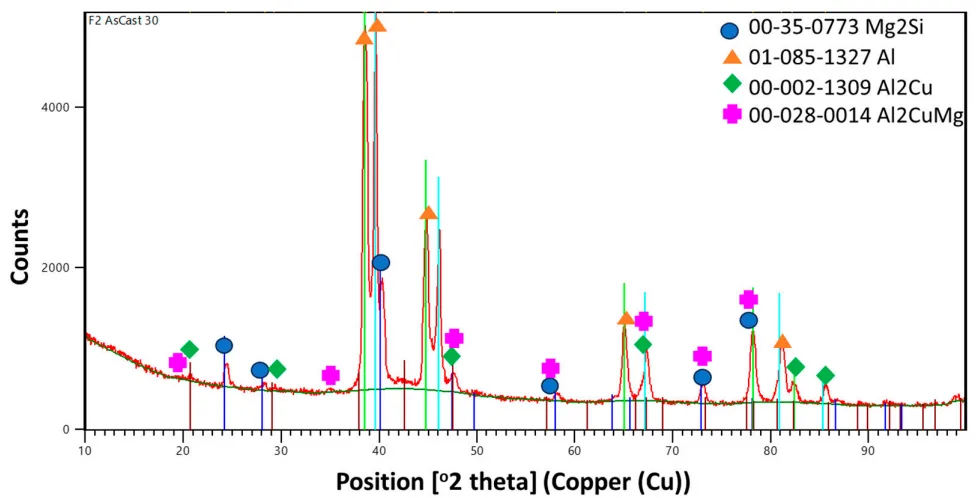
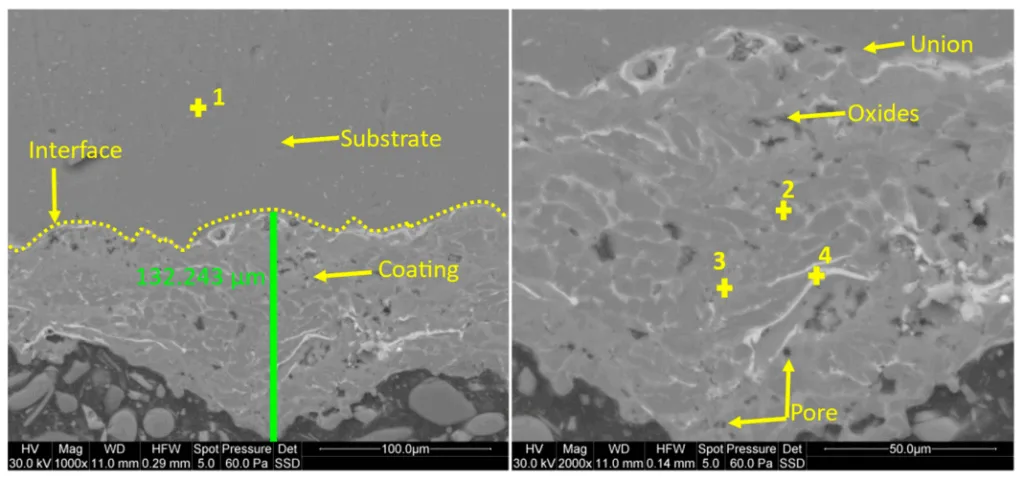
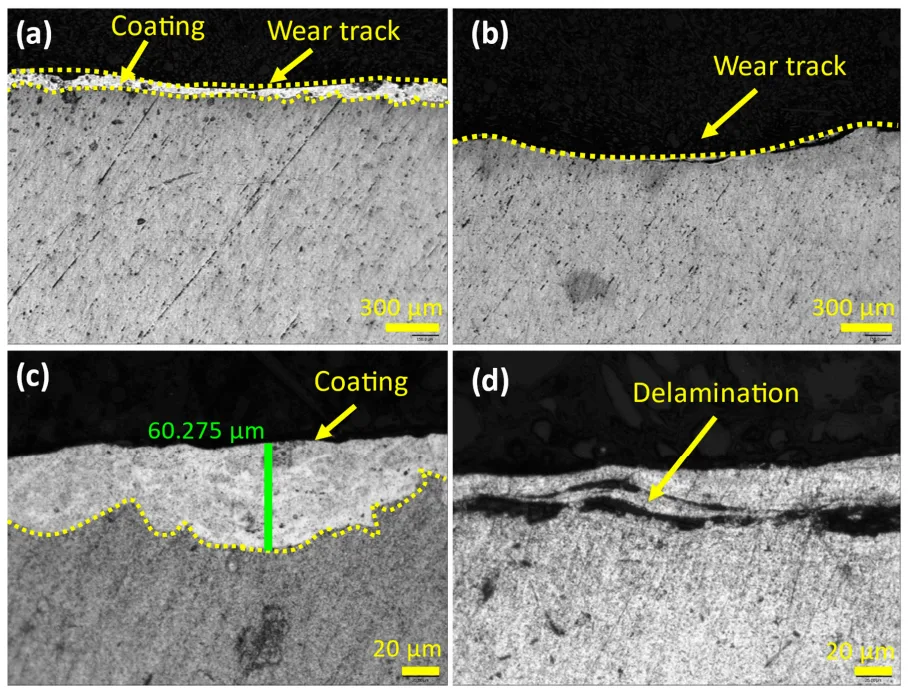
- Figure 1. SEM image of the microstructure of A180Mg10Si5Cu5 powder at ×1000 and ×4000 magnifications.
- Figure 2. Plasma projecting with the robot.
- Figure 3. XRD analysis of A180Mg10Si5Cu5 obtained by HPDC.
- Figure 4. SEM micrographics of the new multicomponent-based coating at the magnification of ×1000 and ×2000.
- Figure 5. Line scan EDS analysis showing the distribution of each element across the different alloys and interfaces.
- Figure 6. EDS map of element distribution in the alloys and interface.
- Figure 7. OM image showing indentations of a sample at the magnification of ×1000 and hardness graph.
- Figure 8. Evolution of the coefficient of friction for the experimental alloys: A6061 with and without the coating, and multicomponent A180Mg10SiCu5 in as-cast state.
- Figure 9. Wearing surface topographies. (a) 3D profile of A6061 with the coating; (b) 3D profile of A6061 without the coating; (c) 2D profile of A6061 with the coating; (d) 2D profile of A6061 without the coating.
- Figure 10. Laser confocal image of wear track at low magnification (a) A6061 with the coating, (b) A6061 without the coating at high magnification, (c) A6061 with the coating, and (d) A6061 without the coating.
- Figure 11. Laser confocal image of the cross-sectional microstructure, (a) A6061 with the coating at low magnification, (c) A6061 with the coating at high magnification, (b) A6061 without the coating at low magnification, and (d) A6061 without the coating at high magnification.
- Figure 12. Comparison of microstructures in the A180Mg10Si5Cu5 multicomponent alloy at different cooling rates.
- Figure 13. Correlation of %IACS with solution components and cooling rates.
7. Conclusion:
The study successfully demonstrated that a new coating based on a multicomponent Al80Mg10Si5Cu5 alloy, applied via a novel HVOAF thermal spray system, significantly enhances the mechanical, electrical, and tribological properties of A6061 aluminum. The coating provided a 50% increase in hardness, a 3.3-fold increase in electrical conductivity (vs. the as-cast coating alloy), a 20% reduction in friction, and a 50% reduction in wear rate. The high solidification rate of the process resulted in a fine, well-adhered microstructure with favorable phase transformations. These results suggest that such coatings present a significant opportunity for the automotive industry, particularly for electric vehicles and hydrogen applications, by enabling the use of lightweight aluminum in more demanding roles. Future work will focus on optimizing thermal spray parameters to further improve properties like corrosion resistance and coating thickness.
8. References:
- [List the references exactly as cited in the paper, Do not translate, Do not omit parts of sentences.]
- Tisza, M.; Czinege, I. Comparative study of the application of steels and aluminium in lightweight production of automotive parts. Int. J. Lightweight Mater. Manuf. 2018, 1, 229–238. [CrossRef]
- Hanif, H.; Wang, T.; Su, L.; Li, H.; Zhu, Q.; Yang, A.; Li, Z.; Wang, W.; Zhu, H. In Situ Thermal Interactions of Cu-Based Anti-Corrosion Coatings on Steel Implemented by Surface Alloying. Coating 2024, 14, 722–739. [CrossRef]
- Barbezat, G. Application of thermal spraying in the automobile industry. Surf. Coat. Technol. 2006, 201, 2028–2031. [CrossRef]
- Sun, W.; Wei-Yee, A.; Wu, K.; Yin, S.; Yang, X.; Marinescu, I.; Liu, E. Post-Process Treatments on Supersonic Cold Sprayed Coatings: A Review. Coatings 2020, 10, 123. [CrossRef]
- Gaur, U.; Kumari, E. Applications of Thermal Spray Coatings: A Review. J. Therm. Spray Technol. 2024, 4, 106–114. [CrossRef] [PubMed]
... [and so on for all 123 references]
Expert Q&A: Your Top Questions Answered
Q1: Why was a hybrid HVOAF process chosen over a standard HVOF or plasma spray technique?
A1: The paper explains that this newly designed HVOAF system combines the supersonic combustion of HVOF with the thermal energy of a plasma torch and an auxiliary cold gas. This hybrid approach increases the flexibility of the spray system in terms of operating parameters and the range of materials that can be sprayed. It allows for enhanced control over the process temperature, which is critical when coating a low-melting-point material like aluminum to achieve strong adhesion without damaging the substrate.
Q2: The paper notes that the Al2Cu phase, present in the as-cast alloy, was not observed in the final coating. What is the significance of this change?
A2: This is a key microstructural transformation. Due to the rapid cooling and solidification rates of the HVOAF process, the Al2Cu phase dissolved and reformed as the Al2CuMg phase. As stated in the paper, the Al2CuMg phase provides higher strength and hardness values than the Al2Cu phase. Its precipitation, especially at the coating-substrate interface, is a primary reason for the observed increase in hardness (up to 200 HV10 at the interface) and the excellent adhesion of the coating.
Q3: How exactly does the coating's wear mechanism differ from the uncoated A6061 substrate?
A3: The wear mechanisms are fundamentally different, indicating a shift from severe to mild wear. The uncoated A6061 alloy exhibited multiple wear mechanisms, including plowed areas (abrasion) alongside delaminated areas and cracks (adhesion). In contrast, the wear track on the HVOAF-coated sample consisted almost exclusively of plowed areas, indicating a purely abrasion wear mechanism. This demonstrates the coating's superior anti-adhesive properties, which prevent the material tearing and delamination that leads to rapid failure in the uncoated substrate.
Q4: What is the primary reason for the dramatic 3.3-fold increase in electrical conductivity of the coated material compared to the as-cast Al80Mg10Si5Cu5 alloy?
A4: The paper attributes this significant increase to the microstructural transformations caused by the thermal process and the extremely high solidification rates (around 10⁶ °C/s). As shown in Figure 13, higher cooling rates lead to a finer, more dispersed microstructure (ultrafine Mg2Si and lamellar Al2CuMg) and a supersaturated solution of copper in the aluminum matrix. This alteration in the form, size, and morphology of the alloying constituents directly enhances the electrical conductivity of the alloy.
Q5: The corrosion rate of the coating was slightly higher than the A6061 substrate. Is this a performance trade-off?
A5: While the corrosion rate was slightly higher than the as-cast A6061 substrate, the paper notes it was comparable to or better than heat-treated A6061 and other conventional aluminum alloys. The high levels of silicon and copper in the coating alloy typically contribute to poorer corrosion resistance. The authors suggest this is not a major trade-off and that the corrosion performance can be improved further by optimizing process parameters like preheating and the angle of incidence, which were not the focus of this initial study.
Conclusion: Paving the Way for Higher Quality and Productivity
The challenge of enhancing standard aluminum alloys for high-performance roles has been met with a powerful new solution. This research demonstrates that a novel multicomponent Al80Mg10Si5Cu5 alloy, when applied via a hybrid HVOAF Coating process, creates a surface that is harder, more wear-resistant, and more electrically conductive. The breakthrough lies not only in the advanced material but in the scalable thermal spray process that unlocks its potential, resulting in a 50% increase in hardness and a 55% reduction in wear rate. For R&D and operations teams, this opens the door to using cost-effective, lightweight aluminum in applications previously thought impossible.
At CASTMAN, we are committed to applying the latest industry research to help our customers achieve higher productivity and quality. If the challenges discussed in this paper align with your operational goals, contact our engineering team to explore how these principles can be implemented in your components.
Copyright Information
This content is a summary and analysis based on the paper "Study of a New Novel HVOAF Coating Based on a New Multicomponent Al80Mg10Si5Cu5 Alloy" by "Ester Villanueva, et al.".
Source: https://doi.org/10.3390/coatings14091135
This material is for informational purposes only. Unauthorized commercial use is prohibited.
Copyright © 2025 CASTMAN. All rights reserved.